I have 2 solutions that use ASP.NET Core Identity. One is v.2.2 the other is 3.0. They make calls to UserManager.IsInRole(user, role.Name). The code works in v.2.2 but throws an exception, "InvalidOperationException: There is already an open DataReader associated with this Command which must be closed first." in v.3.0. They both are building two list of users, one of users in the target role and the other of user NOT in the target role. The idea is to add or remove users from the target role.
I've searched here, the Microsoft documentation and some blogs, but nothing seems to address my issue
Here is the code in quesion:
public async Task<IActionResult> OnGetAsync(string id)
{
IdentityRole role = await roleManager.FindByIdAsync(id);
List<FREEIncUser> members = new List<FREEIncUser>();
List<FREEIncUser> nonMembers = new List<FREEIncUser>();
foreach (FREEIncUser user in userManager.Users)
{
var list = await userManager.IsInRoleAsync(user, role.Name) ? members : nonMembers;
list.Add(user);
} // end foreach (FREEIncUser user in userManager.Users)
RoleUserViewModel = new RoleUserViewModel
{
Role = role,
Members = members,
NonMembers = nonMembers
};
return Page();
} // end public async Task<IActionResult> OnGetAsync(string id)
Here are some screenshots:
v.2.2

This generates an exception: An unhandled exception occurred while processing the request. InvalidOperationException: There is already an open DataReader associated with this Command which must be closed first.
Microsoft.Data.SqlClient.SqlCommand+<>c.b__164_0(Task result)
Stack Query Cookies Headers Routing
InvalidOperationException: There is already an open DataReader associated with this Command which must be closed first.
Microsoft.Data.SqlClient.SqlCommand+<>c.<ExecuteDbDataReaderAsync>b__164_0(Task<SqlDataReader> result)
System.Threading.Tasks.ContinuationResultTaskFromResultTask<TAntecedentResult, TResult>.InnerInvoke()
System.Threading.Tasks.Task+<>c.<.cctor>b__274_0(object obj)
System.Threading.ExecutionContext.RunInternal(ExecutionContext executionContext, ContextCallback callback, object state)
System.Threading.Tasks.Task.ExecuteWithThreadLocal(ref Task currentTaskSlot, Thread threadPoolThread)
Microsoft.EntityFrameworkCore.Storage.RelationalCommand.ExecuteReaderAsync(RelationalCommandParameterObject parameterObject, CancellationToken cancellationToken)
Microsoft.EntityFrameworkCore.Storage.RelationalCommand.ExecuteReaderAsync(RelationalCommandParameterObject parameterObject, CancellationToken cancellationToken)
Microsoft.EntityFrameworkCore.Storage.RelationalCommand.ExecuteReaderAsync(RelationalCommandParameterObject parameterObject, CancellationToken cancellationToken)
Microsoft.EntityFrameworkCore.Query.RelationalShapedQueryCompilingExpressionVisitor+AsyncQueryingEnumerable<T>+AsyncEnumerator.MoveNextAsync()
System.Runtime.CompilerServices.ValueTaskAwaiter<TResult>.GetResult()
Microsoft.EntityFrameworkCore.Query.ShapedQueryCompilingExpressionVisitor.SingleOrDefaultAsync<TSource>(IAsyncEnumerable<TSource> asyncEnumerable, CancellationToken cancellationToken)
Microsoft.EntityFrameworkCore.Query.ShapedQueryCompilingExpressionVisitor.SingleOrDefaultAsync<TSource>(IAsyncEnumerable<TSource> asyncEnumerable, CancellationToken cancellationToken)
Microsoft.AspNetCore.Identity.EntityFrameworkCore.UserStore<TUser, TRole, TContext, TKey, TUserClaim, TUserRole, TUserLogin, TUserToken, TRoleClaim>.IsInRoleAsync(TUser user, string normalizedRoleName, CancellationToken cancellationToken)
Microsoft.AspNetCore.Identity.UserManager<TUser>.IsInRoleAsync(TUser user, string role)
FREEInc.WebUI.Pages.RoleAdmin.ManageUsersModel.OnGetAsync(string id) in ManageUsers.cshtml.cs
var list = await userManager.IsInRoleAsync(user, role.Name) ? members : nonMembers;
Microsoft.AspNetCore.Mvc.RazorPages.Infrastructure.ExecutorFactory+GenericTaskHandlerMethod.Convert<T>(object taskAsObject)
Microsoft.AspNetCore.Mvc.RazorPages.Infrastructure.ExecutorFactory+GenericTaskHandlerMethod.Execute(object receiver, object[] arguments)
Microsoft.AspNetCore.Mvc.RazorPages.Infrastructure.PageActionInvoker.InvokeHandlerMethodAsync()
Microsoft.AspNetCore.Mvc.RazorPages.Infrastructure.PageActionInvoker.InvokeNextPageFilterAsync()
Microsoft.AspNetCore.Mvc.RazorPages.Infrastructure.PageActionInvoker.Rethrow(PageHandlerExecutedContext context)
Microsoft.AspNetCore.Mvc.RazorPages.Infrastructure.PageActionInvoker.Next(ref State next, ref Scope scope, ref object state, ref bool isCompleted)
Microsoft.AspNetCore.Mvc.RazorPages.Infrastructure.PageActionInvoker.InvokeInnerFilterAsync()
Microsoft.AspNetCore.Mvc.Infrastructure.ResourceInvoker.<InvokeNextResourceFilter>g__Awaited|24_0(ResourceInvoker invoker, Task lastTask, State next, Scope scope, object state, bool isCompleted)
Microsoft.AspNetCore.Mvc.Infrastructure.ResourceInvoker.Rethrow(ResourceExecutedContextSealed context)
Microsoft.AspNetCore.Mvc.Infrastructure.ResourceInvoker.Next(ref State next, ref Scope scope, ref object state, ref bool isCompleted)
Microsoft.AspNetCore.Mvc.Infrastructure.ResourceInvoker.<InvokeFilterPipelineAsync>g__Awaited|19_0(ResourceInvoker invoker, Task lastTask, State next, Scope scope, object state, bool isCompleted)
Microsoft.AspNetCore.Mvc.Infrastructure.ResourceInvoker.<InvokeAsync>g__Logged|17_1(ResourceInvoker invoker)
Microsoft.AspNetCore.Routing.EndpointMiddleware.<Invoke>g__AwaitRequestTask|6_0(Endpoint endpoint, Task requestTask, ILogger logger)
Microsoft.AspNetCore.Authorization.AuthorizationMiddleware.Invoke(HttpContext context)
Microsoft.AspNetCore.Authentication.AuthenticationMiddleware.Invoke(HttpContext context)
Microsoft.AspNetCore.Diagnostics.DeveloperExceptionPageMiddleware.Invoke(HttpContext context)
The throwing line is:
var list = await userManager.IsInRoleAsync(user, role.Name) ? members : nonMembers;
Any help and guidance would be greatly appreciated. Thank you.

![Invoke ManageUsers for a role(v.3.0)]](../../images/3859811537.webp)